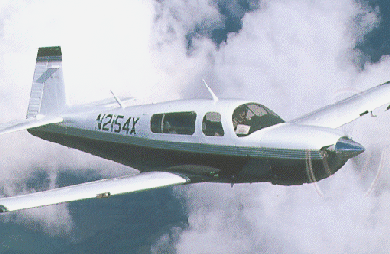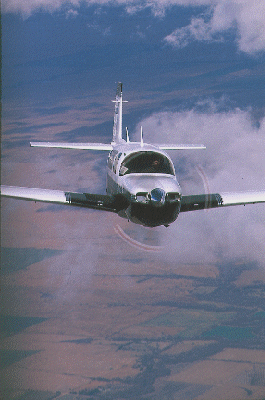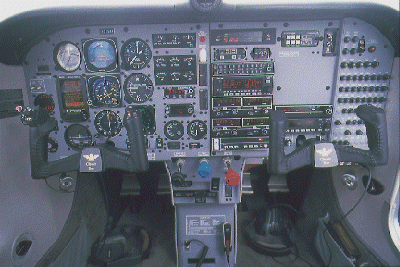
Dave Higdon/KANSAS CITY
Breaking out into the sunshine and levelling off the new Mooney Bravo high-performance piston single just above the cloud at 6,000ft (1,830m) brought home graphically the speed we were making.
Billowing cloud tops blurred past the windows at more than 200kt (110km/h) as we raced south west toward Wichita, Kansas, and our destination of Augusta Municipal Airport. Flying nap of the clouds in Mooney Aircraft's top-of-the-line model imparts a sense of speed not available at the flight levels at which this aircraft normally flies.
An instrument-flight clearance from Kansas City Center gave me a 2,000ft altitude box that kept me legal while climbing, diving, twisting and turning the Bravo across the textured tops as we sped along against a 40kt headwind.
Although far from fighter-manoeuvrable, the Bravo responded well, if not lightly, to my efforts to keep the 200kW (270hp) Textron Lycoming TIO-540-AF1B-powered speedster at the edge of the undercast. The AlliedSignal Bendix/King KLN89B global positioning system (GPS) showed our progress across the ground at more than 170kt. Time taken for the 270km (145nm) trip was 1h 5min.
Speeds like that ensure that Mooney's most expensive offering remains among the more popular turbocharged aircraft. Pure speed will easily draw pilots' admiration, but to persuade them to write cheques for just over $500,000 requires a little more. This aircraft, fully equipped for instrument flight rules (IFR) flying - including a certificated anti-ice system - is one that delivers that little bit extra.
The Bravo offers climb capabilities that can take a pilot rapidly to the right altitude for the best winds. Avionics and flight management equipment keep tabs on the aircraft and its situation, while the payload and space give pilots the flexibility to match fuel to the load and mission.
Although larger and more accommodating than the Encore, in some ways the Bravo is an easier and more stable aircraft to fly, while giving away none of the efficiencies of its smaller sibling.
Mooneys may be among the easiest of general aviation aircraft to identify, because of their distinctive perpendicular vertical stabiliser, but distinguishing among various models is not always so easy. The company has not made that task easier as its product line has evolved in recent years. Ideas introduced on one model - such as roomier interior finishings, instrument panel design, etc - have quickly been adopted for others.
Differentiating between today's Mooneys may be a little easier, however, because of a 500mm fuselage stretch that produced the naturally aspirated Ovation from the MSE (now called the Allegro) and, in turn, the turbocharged Turbo Lycoming Saber (TLS) and TLS Bravo from the Ovation.
Today's Mooneys all have five windows, including the sleek one-piece windshield, but it is the aft fuselage windows that identify the Ovation and Bravo, with their stretched fuselages, from the Allegro and Encore, which are of standard length.
While the windows are long and rectangular on all four models, the two stretched airframes each have a window which is about 25% longer, easily identified by a fuselage-structure tube that passes vertically alongside it about three-quarters of the way back.
To differentiate between the naturally aspirated and turbocharged versions of either airframe requires looking for a logo in the tail - until, that is, you climb aboard and fire up the engine. The instant you spy a manifold pressure gauge calibrated for a red line of 965mm (38in) of mercury it should be apparent that the Bravo is turbochargeable.
It was also a change in the engine that transformed the TLS into the Bravo. Mooney developed the TLS in 1989 and achieved moderate success with the "hot rod" four-seater. Keeping engine temperatures in the green, however, was a problem that kept pilots from fully exercising the capabilities of the TIO-540. This was a common problem for turbocharging, which produces higher temperatures.

EVOLVED ENGINE
In 1996, Mooney and Lycoming unveiled the results of a collaboration to solve the excess heat problem. The result was the TIO-540-AF1B - which brought on the Bravo name. The evolved engine included some minor changes and one major evolution: oil cooling directed on to the exhaust valve stems and guides of the big six-cylinder engine.
Lycoming designed a system that feeds cooling oil to each cylinder's exhaust-valve assembly through an individual insulated line for each head. In addition, the company improved on the valve guides themselves, to reduce wear. The result is an engine that can be driven at 90% power continuously as long as turbine-inlet temperatures stay in line - below a glowing 955°C.
As with most turbocharged singles, the Bravo shines when going high and fast. The fast part applies to climbing, as well as to cruising at altitude. Arguably, the aircraft has one of the cleanest airframes in general aviation.
The process starts with the engine. Because of the intercooled turbocharging system, the TIO-540-AF1B can achieve full power all the way to 21,000ft and 80% power or more at 25,000ft, the service ceiling.
Managing the power and climb of the Bravo is as easy as it gets, thanks to some of the aircraft's more sophisticated touches. For example, there are no worries about overboosting the engine, because of the automatic waste gate on the turbocharging system.
In cross-country travel, the combination of high power and thin air yields a maximum cruise of 220kt true airspeed at 25,000ft, consuming about 65 litres/h of fuel.
High-altitude dashes are not productive if t half the trip is spent in the climb. In this area the Bravo shines in its capabilities. There is no better example than our flight from Augusta Municipal to Kansas City Downtown Airport, a distance of around 270km.
After my preflight inspection, my companion, Mooney domestic marketing manager Rick Pitner took me through a thorough indoctrination. We then obtained our instrument clearance from Wichita Departure and turned on to Augusta's Runway 18.
There is no need to power up the Bravo's electric fuel boost pump for take-off - a micro-switch in the throttle takes care of that chore. Neither is there the need to wear out your right leg on the rudder pedal on the ground roll and climb-out - electric trim applied full left let me keep my feet on the floor.
The sound of the engine went from a rumbling, throaty exhaust note to a baritone roar as my right hand advanced the throttle vernier to the instrument panel. Instantly, the Bravo surged accelerated, reaching 70kt in less than 20s. At this point, Pitner asked me to rotate the nose up. At 80kt indicated airspeed (about 2s later), the Bravo locked into a climb and we were on our way.
INITIAL CLIMB
Although initially cleared direct to our requested altitude of 19,000ft, Kansas City Center restricted me to 6,000ft. Using Pitner guidance, I reached this ceiling in just over 3min by trimming for the Bravo's best rate of climb speed of 110kt, which gave an average of about 1,500ft/min (8m/s). After 2min at 6,000ft, air traffic control freed me to resume my climb. This time my goal was to maintain a climb rate of 1,000ft/min by adjusting my airspeed.
We reached 19,000ft right after my chronograph ticked over 19min - from take-off at an airport 1,328ft above sea level. That made it more than 900ft/min on average, and including 2min of level flight. It was a cool damp day below the cloud base, however, and the aircraft, with about 60% fuel, and two people aboard, was about 135kg below its gross weight of 1,530kg.
Impressively, the Bravo continued to make 1,000ft/min of climb as we passed through 17,000ft up to 18,500ft, where the climb was slowed simply by trimming down the nose. I believe that the Bravo continues to be capable of 1,000ft/min well above 20,000ft.
Even for our brief dash up, supplemental oxygen was required and provided by the Bravo's integral 3.3m³ (115ft³) oxygen system. The standard system is plumbed to all four seats. Before I could adjust the regulator for our altitude, however, air traffic control (ATC) sent us earthward again. With our tailwind, this did not leave much time at the cruise height.
From my time in the Bravo and, earlier in the year, the Encore, my instincts tell me that with speed the former increases in stability, even as it climbs. In fact, the longer Bravo has better dynamic stability around the vertical axis than does the Encore, obviating the need for the yaw damper that is standard on the shorter aircraft.
Since ATC wanted an expedited descent, it seemed wiser to pitch the nose down slightly with power-on versus pulling off the power. That decision brought the airspeed indicator ever higher until the Bravo's groundspeed edged towards 300kt, according to the GPS.
With the Bravo's standard electrical speedbrakes, ATC got the descent needed to maintain our approach to the airport, delivering descent rates exceeding 3,000ft/min. With all this high-velocity, three-dimensional, in-the-blind flying, keeping track of our position might have taxed even an airline captain.

A 130 x 178mm Argus flat panel colour display provided me with a clear picture of our proximity to the airport, however, even as we made a thick overcast descent, covering the ground at more than 3km/min. The Argus information came from the GPS, itself capable of displaying a scaleable map.
There is nothing wrong with two sources of graphic, situational information, nor with the standard Shadin fuel-flow system, which provides a wealth of fuel-management information beyond simple fuel-flow numbers. With speed, range and estimated time of arrival data from the GPS, the Shadin calculates fuel used, fuel remaining and even projects fuel remaining at your destination, based on current progress. As the GPS updates the numbers, so does the Shadin.
The Bravo's annunciator panel also enhances pilot awareness, with low fuel , low vacuum and low voltage warnings, the failure of either alternator or vacuum pump and even an indication that the electric fuel boost pump has engaged when the throttle is advanced to full power.
Of course, as with any turbocharged aircraft, the Bravo does have some extra demands in the power management department. Pitner recommends running the mixture on the rich side at peak turbine-inlet temperature to the tune of about 4 litres/h fuel flow to help keep the engine cool.
Mooney and Lycoming recommend gradual power reduction during descents, about an inch of manifold pressure per 1,000ft. Likewise, 1in power reductions should prevail when slowing in the pattern. Prudence also demands idling the engine for a 5min cool-down period after landing, to avoid heat soaking the turbocharger bearings and coking the oil. Following these steps should go a long way toward the engine making the full 2,000h recommended time between overhauls.
Recent experience in the Encore left me better prepared for managing the engine as the Kansas City approach vectored me toward the runway. In pure flying terms, the Bravo performed admirably. Starting turns, holding bank angles, and sliding down the glideslope with a little power came easily.
As with the Encore, earning a smooth touchdown requires continuing the descent towards the threshold and running the electric trim to full up as the runway nears - in other words, do not try to flare the Mooney. This may sound difficult, but, in practice, it comes quickly - and with no risk of porpoising back into the air or striking the tail during a deep stall near the runway.
It worked well during my landing at Kansas and again at Augusta Municipal on the return flight. Everything the Bravo taught me on the flight north, it did with remarkable efficiency. Between the Bravo's cruise, climb and descent performance, our outbound trip to Kansas took a scant 46min - even with the climb to 19,000ft.
CONCLUSIONS
Of course, a one stop, round trip flight time of 1h 54min seems too short to provide an honest challenge to the Bravo's capabilities. For such a serious, business-oriented aircraft as the Bravo is this not the true test in living with it for some equally serious business travel?
The answer is mixed. "Yes," because most general aviation aircraft, even "serious business singles", fly more trips of short and medium range than of maximum range. A round trip time of 1h 55min between the Wichita area and Kansas City should warm the hearts of any business flyer who needs to make frequent trips of up to 925km early in the morning, be at the appointment in less than 3h, attend a day's worth of meetings and be home in time to tuck in the children.
It is "No," because the Bravo is at its most efficient travelling on longer legs and itineraries. Furthermore, there are plenty of pilots who embrace the Bravo because they like the answers to questions like these.
How well does the Bravo's baggage space work in the world of a business owner/pilot flying 150-160h a year, with one-third of that time at night, through instrument meteorological conditions for one-quarter of the time and another quarter carrying two passengers, plus their gear, for 12 or 13 days on the road? The answers to those questions come only from living with an aircraft for some time, but, from my own experience in a similarly sized single, my suspicion is that Bravo owners find it quite accommodating for such a profile.
Compared to the short-body Encore, the Bravo is 280mm longer in the luggage compartment and has 100mm more leg room in the back seat. The Bravo unquestionably fills the "two plus gear" profile better than does the Encore. Neither model offers the full tanks, filled seats, maximum luggage mode of flying, however.
If you want legs to the full range of 1,980km (with IFR reserves), then you live with two and their gear, or buy a six-place single or twin. If you are willing to break the trip down into shorter legs, then you have the options of passengers, plus gear. As noted at the start, of course, the most fun moments of the trip fit no standard business-flight profile.
Without a doubt, few pilots would waste precious time and fuel blasting along at 6,000ft in a machine as capable and serious as a Bravo. There will be those, however, who, tired of the lack of speed sensation cruising at higher flight levels, will enjoy flying the Bravo low and fast. Even though the aircraft must be encouraged to zoom and soar, it is worth the effort to sense how truly fast the Bravo can feel with just a little cloud dancing for perspective.
Source: Flight International



















